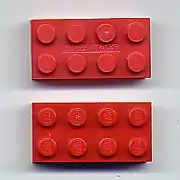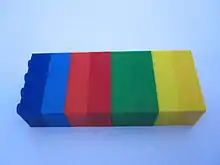Lego clone
A Lego clone is a line or brand of children's construction blocks which is mechanically compatible with Lego brand blocks, but is produced by another manufacturer. The blocks were originally patented by The Lego Group in 1961 as "toy building bricks",[1] and the company has since remained dominant in this market.[2] Some competitors have moved to take advantage of Lego brand recognition by advertising their own products as compatible with Lego, with statements such as "compatible with leading building bricks".[3]


The last underlying patents of the brick design expired in 1978, opening the field to rivals.[4]
Legal challenges
At least two of the largest clone manufacturers have been challenged in court by Lego. The lawsuits have been mostly unsuccessful, for courts have generally found the functional design of the basic brick to be a matter of patent rather than trademark law, and all relevant Lego patents have expired.
Lego itself originally copied their bricks from British psychologist and inventor Hilary Page in the late 1940s.[5][6]
Lego and Tyco Industries fought in US courts over Tyco's line of interlocking bricks in the 1980s with Tyco prevailing.[4] On August 31, 1987, the US District Court ruled that Tyco could continue making Super Blocks, its Lego clone bricks, but ordered Tyco to stop using the Lego trademark and not to state that they were "Lego, but only cheaper". In Lego's Hong Kong suit against Tyco Super Blocks, Lego received an injunction forcing Tyco to stop cloning Lego brick designed after 1973. Tyco was also being sued at the time by Lego in Austria, Italy and Canada.[7]
The Canadian company Mega Bloks was sued on the grounds that its use of the "studs and tubes" interlocking brick system was a violation of trademarks held by Lego. On November 17, 2005, the Supreme Court of Canada upheld Mega Bloks' right to continue selling the product in Canada.[8] A similar decision was reached by the European Union's Court of First Instance on November 12, 2008, upholding an EU regulatory agency's reversal of opinion following an objection by Mega Bloks against a trademark awarded to Lego in 1999.[9] On September 14, 2010, the European Court of Justice ruled that the 8-peg design of the original Lego brick "merely performs a technical function [and] cannot be registered as a trademark."[10]
The English company Best-Lock Construction Toys sued Lego in German courts in 2004[11] and 2009.[12] The German Federal Court denied Lego trademark protection for the shape of its bricks in the latter case.[13]
The Lego Group did score a success in 2002, when its Swiss subsidiary Interlego AG sued the Tianjin CoCo Toy Co., Ltd. company for copyright infringement. A claims court found many CoCo sets to be infringing; CoCo was ordered to cease manufacture of the infringing sets, publish a formal apology in the Beijing Daily, and pay a small fee in damages to Interlego. On appeal, the Beijing High People's Court upheld the trial court's ruling.[14]
In 2000, Lego filed a three-dimensional trademark for its mini-figures, which Best Lock had duplicated since 1998. Thus in 2012, Best Lock sued to get the trademark revoked. On June 16, 2015, European Court of Justice upheld Lego's figure trademark.[15] Lego had in 2009 filed its copyright claims into a U.S. Customs database that led to the seizure of Best-Lock shipments coming in from Asia. In October 2011, Lego filed in US District Court in Hartford filed against Best-Lock over the mini-figure trademark.[5] Mega Bloks won a case at the EU's top court in 2010 against Lego's trademark registration of a red toy building brick.[16]
Jon Capriola came up with the idea of a light up block, Laser Pegs, in 2002 then filed for a patent for the idea in 2006, which was finally granted in 2009. Lawrence Rosen of LaRose Industries was approached by Capriola to invest in February 2011 at the American International Toy Fair. Instead, Rosen filed a fast-track patent and received in 2012. LaRose Industries' Cra-Z-Art division then started producing Lite Brix light up blocks. In 2013, Capriola's company sued Rosen's for patent infringement, while Rosen filed for dismissal of his patent at U.S. Patent and Trademark Office.[17] In 2014, Light Stax were introduced as another LED light compatible bricks. Stax Hybrids sets came out in September 2018 and build on the Light Stax with Light, Sound, Connector and regular Stax bricks allow for light and sound.[18]
In 2011, Lego sued Guangdong Jumbo Grand Plastic Moulding Industrial over its compatible BanBao's copycat packaging. The two companies settled their case out of court with Guangdong agreeing to create unique packaging and a new figure, ToBees.[19]
In 2016, Lego announced that it would be taking legal action against the Chinese company Guangdong Loongon, which manufactures the brand Lepin, for selling exact replicas of existing Lego products (including box-art).[20]
Brands
| Name | Figure | years | manufacturer | refs |
|---|---|---|---|---|
| Best-Lock | 1997–present | Best-Lock Group | ||
| Cobi | ||||
| BanBao | ToBees | 2010–present | Guangdong Jumbo Grand Plastic Moulding Industrial Co., Ltd. | [19] |
| Lepin[20] | MZ Model | |||
| Xingbao | ||||
| Coco | Guangdong Loongon | |||
| Built to Rule | 2003–2005 | Hasbro | [21] | |
| Kre-O | Kreon | 2011–present | [21][22] | |
| Bikku | 2018–present | Keak Japan Co., Ltd. | ||
| Mega Bloks | 1991–present | Mega Brands (Mattel) | [21] | |
| Make-it Blocks | ?–present | proprietary brand of Dollar Tree | ||
| Tyco Super Blocks | 1984–1990 | Tyco Toys/Mattel | [7] | |
| Oxford | Oxford | |||
| Wilko Blox | Wilko | |||
| CoCo | Tianjin CoCo Toy | [14] | ||
| Laser Pegs | Laser Pegs Ventures | [17] | ||
| Lite Brix | Cra-Z-Art (LaRose Industries) | [17] | ||
| N&B Block | 1968-1972 | Nintendo | ||
| Sluban | 2004-present | Sluban | ||
| Qman (formerly Enlighten) | 1994-present | Guangdong Qman Industry Toys Co., Ltd. | ||
| Zuru MAX | Zuru |
- K'Nex sets have included compatible bricks since 2008.
- Ramagon, by Discovery Toys, has some panels with compatible studs
See also
References
- US patent 3005282, Christiansen, Godtfred Kirk, "Toy Building Brick", issued 1961-10-24, assigned to Interlego A.G.
- Joffe-Walt, Chana (2012-12-13). "Why Legos Are So Expensive — And So Popular". NPR. Retrieved 2019-10-14.
Lego has about 70 percent of the construction-toy market
- Gardner, Tracy (14 August 2015). "Laser Pegs Hands-On Review - Light Up Construction Bricks". techagekids.com. Retrieved 1 April 2017.
- Austen, Ian (February 2, 2005). "Building a Legal Case, Block by Block". New York Times. Retrieved October 8, 2018.
- Lee, Mara (January 29, 2012). "Blocking And Tackling: A Nasty LEGO Copyright Battle". Hartford Courant. Retrieved 8 October 2018.
- Seay, Gregory (January 30, 2012). "Lego locked in domestic copyright fight". Hartford Business Journal. Retrieved October 8, 2018.
- Mayer, Caroline E. (September 1, 1987). "Lego, Tyco Each Declare Victory in Battle of the Bricks". Washington Post. Retrieved October 8, 2018.
- "2005 SCC 65". CanLII. Retrieved 2015-03-09.
- "Lego loses trademark ruling in EU". The New York Times. October 12, 2008.
- "Montreal's Mega Brands triumphant after Lego loses trademark challenge". Archived from the original on September 19, 2010. Retrieved December 31, 2011.
- "Forty-year Monopolistic ``LEGO-Doctrine Ruling Reversed as Best- Lock Europe LTD Wins Patent and Trademark Case". CCNMatthews Newswire. 2005-03-28. Archived from the original on 2016-02-25.
- von RA Dennis Breuer (2012-04-19). "Pressemitteilung des BGH Nr. 158/2009: Legostein als Marke gelöscht | markenmagazin:recht". Markenmagazin.de. Retrieved 2012-10-09.
- "Pressemitteilung Nr. 147/04 vom 3.12.2004". Juris.bundesgerichtshof.de. Retrieved 2015-03-09.
- "Lego defeats the Chinese pirates". BBC News. 21 January 2003. Retrieved October 8, 2018.
- Butler, Sarah (June 16, 2015). "Lego blocks legal bid to remove trademark protection for its mini-figures". the Guardian. Retrieved October 8, 2018.
- "EU court rules Lego figurines are protected trademark". 2015-06-16.
- Lagzial, Ashley (June 30, 2013). "Patent Fight Short Circuits 'Laser Peg' Toy Plan". CNBC. Retrieved October 8, 2018.
- "New Hybrid range brings sound to Stax creations". Toy World Magazine. Alakat Publishing Ltd. September 14, 2018. Retrieved 30 December 2018.
- Sauer, Abe (September 24, 2012). "China Watch: Banbao Blames Lego For Not Letting Banbao Copy Lego". Brandchannel. Retrieved October 8, 2018.
- "Fierce copyright battle mars Lego's push in China". cphpost.dk (in Danish). Retrieved 2017-02-08.
- Lennihan, Mark (February 12, 2011). "Hasbro pushes into Lego's land with new blocks". USA Today. AP. Retrieved September 12, 2018.
- Kuchera, Ben (July 20, 2011). "Playing with Hasbro's Kre-O Transformer kits: don't call them Lego". Ars Technica. Retrieved September 12, 2018.